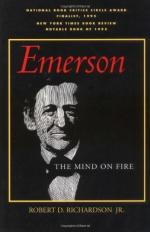
|
| Name: _________________________ | Period: ___________________ |
This test consists of 15 multiple choice questions and 5 short answer questions.
Multiple Choice Questions
1. How did Emerson portray great men?
(a) As demi-gods.
(b) As proto-Americans.
(c) As heroes.
(d) As educators.
2. How does Richardson characterize Sufism?
(a) As the first modern religion.
(b) As the first building block of all subsequent religions.
(c) Not a religion but religion.
(d) Eastern Pragmatism.
3. Who was Hafiz?
(a) A Persian poet.
(b) A Turkish governor.
(c) An Egyptian philosopher.
(d) A Malaysian philosopher.
4. What objection did Emerson make to Charles Fourier's utopian ideas?
(a) He was too pessimistic.
(b) He had too much faith in people.
(c) He was too optimistic.
(d) He was too dependent on science.
5. What does Richardson say was the most important thing in Emerson's life?
(a) His children.
(b) His writing.
(c) His friendships.
(d) His marriage.
6. On what theme did Emerson's letters and journals begin to focus after Margaret Fuller's death?
(a) Time.
(b) Self-reliance.
(c) The sea.
(d) Freedom.
7. What did Margaret Fuller ask Emerson for in 1840?
(a) A closer relationship.
(b) Money.
(c) Advice for her writing.
(d) A recommendation.
8. How does Richardson say Emerson felt in response to the work he did for Carlyle?
(a) Inspired to write poetry.
(b) Humbled so that he could not write.
(c) Motivated to write his own essays.
(d) Afraid of failure and competition.
9. What did Emerson become interested in after discovering Hafiz?
(a) Prints and music.
(b) Asian history.
(c) Science.
(d) The progress of history.
10. What does Richardson say crowds expected from Emerson?
(a) Just to see him was enough.
(b) Encouragement.
(c) Inspiration.
(d) Beautiful speeches.
11. To what moral did Emerson point in his use of great men?
(a) That there are no common people.
(b) That common men are qualitatively different from exceptional men.
(c) That uniqueness is a burden only strong men can bear.
(d) That all men are representative of their race and times.
12. How does Richardson characterize Emerson's feeling about the essay "The Poet?"
(a) He felt more uncertain of that essay than any other.
(b) He was afraid of the censure it would draw.
(c) He was afraid to believe in his own prophecy.
(d) He thought it was one of his best.
13. What was Emerson's response to the publicity that arose from Andrews Norton's article?
(a) He stayed out of it.
(b) He made overtures to Norton through friends.
(c) He corresponded with Norton's superiors.
(d) He answered Norton publicly.
14. How does Richardson characterize 1844 in Emerson's life?
(a) A year of beginnings.
(b) A year of losses.
(c) A year of endings.
(d) A year of transition.
15. By what work of Emerson's was Jones Very impassioned?
(a) The American Scholar.
(b) Nature.
(c) Circles.
(d) The Divinity School Address.
Short Answer Questions
1. Why did Emerson take over editorship of "The Dial?"
2. How does Richardson characterize Emerson's feelings?
3. Who is Osman?
4. In what cause did Emerson involve himself?
5. What was Emerson's frame of mind on returning from Europe?
|
This section contains 512 words (approx. 2 pages at 300 words per page) |

|




